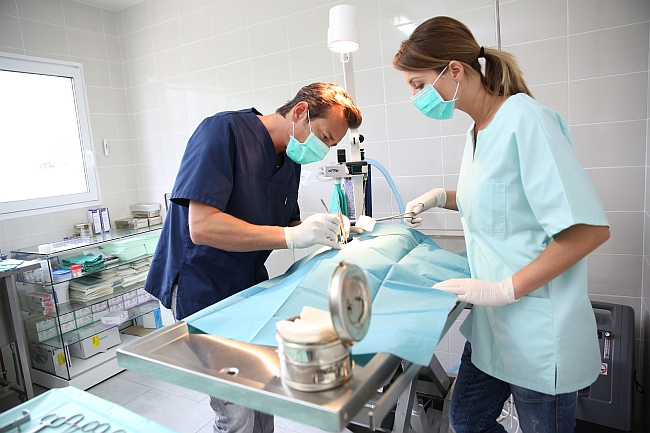
We know humans justify spending thousands of dollars to chase eternal youth, or correct features they dislike on themselves, but would they do the same for pets? Apparently nip and tucks have become popular surgeries to perform on pets in recent years. While some of the plastic surgeries are done for the benefit of the animal’s health, it would appear that many of them are simply for cosmetic purposes, having little to no medical value.
How much could pet owners really want to give their chubby pooch a tummy tuck, or add silicone testicles to an emasculated dog, or shave down that unattractive lump in a pup’s nose? Surprisingly, just five years ago in 2010, an estimated $2.5 million was spent on pet rhinoplasty procedures alone. Imagine how the numbers have jumped off the charts with the addition of numerous other plastic surgeries available to domestic pets. Review the list below to acquaint yourself with what many unfortunate dogs and cats now experience under the knife.
Plastic Surgery for pets
Pet Braces: Some pet owners attempt to correct a dog’s mouth alignment or improve the straightness of a dog’s teeth through dental braces.
Eye Replacement: For eyes that might have been lost in a fight, or simply absent as a birth defect, many owners decide to get eye replacement surgery instead of covering it with a patch.
Eye lifts/Face lift: Certain dog breeds are most inclined to struggle with layers upon layers of folding skin. At times this sagging skin impairs a dog’s vision, causing pet owners to opt for an eye lift.
Nose Job (Rhinoplasty): Competitive dog showers sometimes correct the bumps in their dog’s nose, so that he will be more closely aligned to the breed standard. Other pet owners whose dogs have trouble breathing (such as Pugs and Bulldogs) might also have their dog get nose surgery.
Ear Implants: These are often used for breeds that are known for their stand-up ears, such as German Shepherds, Dobermans and Boxers who may have damaged, broken or folded ears. The implant helps the ears to stand erect again.
Liposuction: Because of the number of obese pets in American, liposuction has actually become a popular way to help domestic animals get their weight under control. (NOTE: Most vets advise that correct portion control and exercise are a much better way to go.)
Tummy tucks: After a dog or cat has lost a fair amount of weight, they sometimes are given a tummy tuck to help remove the excess skin.
Testicular Implants (Neuticles): When dogs have been neutered, some owners feel that it has an effect on the dog’s self perception and confidence. The manufacturing company of the silicone testicles claims that over 500,000 dogs have had the surgery; as of 2011, $62 million were spent on this procedure in American alone.
When is Plastic Surgery Necessary?
While most people regard pet cosmetic surgeries to be nothing more than the superfluity of wealthy America, others believe that that some animals need minor alterations to thrive.
Some plastic surgeons, such as the leading Brazilian canine cosmetic surgeon Dr. Edagrd Brito, argue that it is best for the pet to have the correct physical proportions and facial expressions, especially if they are show dogs. He claimed that pets should be as “beautiful as their owners want them to be.” Many people view dogs as a pet owner’s property, and that they can be treated anyway his owners please. But why should cats and dogs have to suffer needlessly, just because their owner finds an aspect of their physique “unsightly?”
It seems ridiculous to consider ear implants or neuticles to be “necessary” when all they accomplishes is the owner’s idea of a more “attractive pet” while forcing the animal to undergo a painful procedure. Many veterinarians and animal rights activists view this kind of medically unnecessary surgery to exhibit cruelty to animals.
Aside from the cosmetic surgeries, might there cases where plastic surgery procedures might be needed? There have been cases of Blood Hounds and Sharpeis being unable to see because of the folds of skin that cover their eyes. In other cases, there have been previously obese pets which have lost plenty of weight, leaving saggy skin which causes them to trip frequently. One particular Dachshund named Obie lost almost 50 lbs, only to have his stomach skin dragging on the floor under his short legs. In order to move freely without being at risk of falling, Obie had the excess skin surgically removed. This use of plastic surgery certainly aided a dog’s health instead of needlessly amending his features.
Similarly, when dogs suffer from respiratory difficulties, they could benefit significantly from nose surgeries. For procedures that directly affect an animal’s health and fullness of life, many veterinarians prefer to call these “corrective surgeries” instead of cosmetic surgeries.
In what cases should plastic surgery be universally considered ethically acceptable for pets? Our belief is that when the surgery is necessary to support the pet’s well being; then plastic surgery is acceptable. Only for medical reasons should a dog or cat be subjected to such operations; not for vanity or their owner’s whim.

